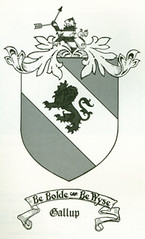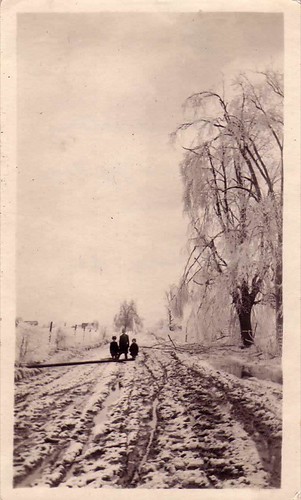
While researching my family tree, I came across these Civil War letters from my fourth great uncle, Horace B. Jewell. He describes his experience breaking out of Danville Prison in 1864 in great detail, writing to his brother, Charles Adolphus Jewell.
You can view more information about Horace and Charles Jewell on our Geni family tree site. After finding the letters I shared them with Census Diggins and the letters were posted on the Danville Prison website. Enjoy!
Letter #1:
Nashville February 3rd 1864
Dear Charlie [Charles Adulphos Jewell], I arrived in town last nite from Louisville on my way to my regt. I was captured on the 4th of Nov. taken to Atlanta Ga, from there to Richmond, from Richmond to Danville Pn, 140 miles S.W. from Richmond. I remained in prison until the 27th of December when I escaped by cutting the bars off the window and running through the guard lines, two sentinels fired at me, one ball hit me in the right shoulder, cutting a hole about two inches in length and about the size of the ball, and passed out through my coat on the left shoulder, it was only a slight wound, and did not prevent my running. I was 25 days getting through to our lines. I got to our lines on the 21st of Jan at South Washington, at the mouth of the Tar river in North Carolina on Palmics Sound, there I got transportation to New Berne at which place I wrote to you directing the letter to Nashville but Chatfield says the letter has not got here yet.
I went from Newbern to Fort Monroe, from there to Baltimore from there to Cincinnati, from there to Louisville and from there to Nashville. I shall take the 3 Oclock train this evening for Chattanooga.
I am disappointed at not seeing you but am glad you are at home. I should like to have gone home, the boy who escaped with me went home to stay a while before reporting to his regt, but I thot it my duty to go to my regt as soon as I could.
I wrote to my Co. and Regimental commanders as soon as I got into our lines telling them that I had escaped and was on my way to the regt. Chatfield has let me have five dollars which if you will pay him I will send you as soon as I get paid. I wanted to get some things to take to the regt which I cannot get there, such as tobacco, emery paper, coffee pot etc.
Andrew Jewell tells me there is a commission here for you as 1st Lt in Co. I which I am glad to hear, give my love to all the folks, and all write to me. I am anxious to hear from home. I suppose you would like to know how I traveled thru the Confederacy without getting caught but I haven’t time to write much. I traveled by night and laid in the woods by day, stole chickens and sweet potatoes and cooked them in the woods. Crossed streams where the bridges were guarded by making rafts of rails etc. You must write to me as soon as you get this and tell me of your prospects.
H. [Horace] B. Jewell
P.S. Direct to Chattanooga
Letter #2:
Camp Chickamauga
February 22nd, 1864
Dear brother, I received your long and welcome letter last night, and fearing that we might leave tomorrow, I leave a dirty gun in the stach to answer it. In accordance with your request I will give you a brief account of my escape from the rebel prison at Danville, Va. There were 3000 of us taken from Castle Pemberton in Richmond to Danville, 140 miles SW from the former place and confined in four prisons, old tobacco factories four stories high, on the windows of which the rebs had put bars at outside of the glass. The guards were stationed about 15 or 20 ft outside of the prison and 20 ft distant from each other facing the prison, with positive orders to hold no communication with, or even speak to a prisoner. I had resolved from the first to improve the first opportunity to escape, and the first two weeks of my stay was devoted to forming the acquaintance of my companions who looked as though they would be desirable companions for such an undertaking. I knew we had 280 miles of the enemy’s country to go through before we could reach our lines; it required men who had the courage and perseverance to endure cold, hunger and fatigue for an indefinite period of time, and at the same time the presence of mind to meet and conquer any unlooked for danger that we should always be liable to encounter. I found plenty of men who would talk escape, oh yes, they would like a chance to go; but when I pointed out the only way which we could escape from the prison, some would not incur the risk. Others when I had got their courage screwed up to that and pointed out one danger after another we should be likely to encounter after we had got out, before we arrived at our lines, and asked their opinion as to the best method of surmounting them, I found none of them such men as I wanted except one orderly and two duty sergeants belonging to the 18th Pa Calvary. I proposed to cut the bars of a window myself and let them know when I was ready, then the first dark rainy night we would go. Well, I got the bars cut so that a mere splinter held them in their place and the cracks carefully stopped with charcoal and tallow. One well directed blow would knock them off. We waited several days for rain and at last it came. I told them we would go that night, showed them the bars I had cut, and pointed out the lane we should go through and the direction we should take when we reached the street beyond. But said one that lane leads past the guard quarters, not 10 yards distant, we can’t go past that it is brightly lit up all night. If the guards see and fire at us, it will alarm the corporal and guard who will rush out and we shall be in a trap. I replied, you are correct in everything but the trap. The guards must see and hear us break the bars off, they will fire at us, but the close proximity of the guard-quarters will give us time to pass it before thy can get out. We can’t sneak out of this like a thief out of jail, where there are no guards, but must make a bold dash for liberty and take our chance.
What then is the use of a dark rainy night, said another. “To keep the guards guns under their coat capes and their eyes full of water, so that they will not have time to deliberate aim until we get past them, and they will fire in a hurry and miss us. Then it will help us about passing the picket lines, for we can sneak through them.” Well, said another, if Old Abe don’t want me bad enough to exchange me, I don’t feel called upon to run so much risk as one chance out of ten for escape, nor do I, said the other two. Very well, said I, I thought you were brave men, but I see you are cowards. I don’t want you. When I thought it time to go, I went to the window. I could plainly see by the light which shone from the windows of the guard house (a 3 story brick, built unfurnished by a union man who had to flee his country) every one of which was lit up by the light of pine knots burnt by the guards, that the two sentinels between which I had to pass were standing with their muskets under their blankets and their heads bent towards the rain, apparently half frozen. I carefully removed the glass from the window and then thinking I would give every man a chance to follow me I woke up about 40 and told them they could leave Dixie if they wished. They crowded around the window, but when they saw what the chance was they “turned back”. I called them all a set of cowards, and dared anyone in the room to follow me. A boy of 16 yrs from the 41st O.R.I. Ohio answered, “It is a scaly chance, but I am tired of this. I’ll follow you or die trying.” “Come on, then.” Said I, and I kicked out the bars and jumped out, turned around and took him by the hand and pulled him out, set him on his feet and said “now run like the devil.” We started, “halt.” “halt”! “halt!” bang, bang. Corporal of the guard No 7 to No 8 and we were away. I felt a ball spat against my shoulder but it inflicted only a slight wound and didn’t hinder my running. It took us all night to get past the pickets, when we got news where we thought they out to be we crawled on our hands and knees, stopping every few feet to listen. Just before daylight we found them and succeeded in getting through unobserved, we were then clear of the town, and traveled about two miles when we found an old tobacco barn on the backend of a plantation filled with corn fodder. We crawled in amongst this and laid during the day, and when night came we set out. We knew that the ____ of N.C. was within 300 miles of us, took the Stars for our guide, traveled by night and laid in the woods by day, lived on chickens and sweet potatoes which we captured from rebs and cooked in the woods. We had yet many difficulties to contend with. The bridges and ferries are all guarded to catch their soldiers who desert and go home by hundreds. So that we had to feel our way, when we had a stream to cross we went below the bridge or ferry and made rafts of rails, old logs or anything we could find. Sometimes our rafts came to pieces in the middle of the stream and we had to gather as many rails as we could under our arms and swim with the other.
 Valuing distant memories & keeping them alive for our children.
Valuing distant memories & keeping them alive for our children.




